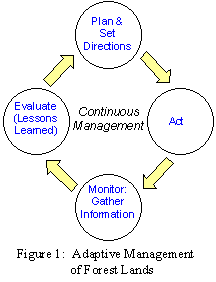Objectives
Locations
Research &
Monitoring
Network
Activities
Strategy and
Plan of Work
Sponsors
Links
Site Map
Adaptive Management Area Network Objectives
Adaptive Management Areas are landscape units designated to encourage the development and testing of technical and social approaches to achieving desired ecological, economic, and other social objectives. Each area is meant to pilot adaptive management, thus promoting learning about how to manage in an adaptive management framework.
Ten areas ranging from about 92,000 to nearly 500,000 acres of federal lands have been identified. The areas are well distributed in the physiographic provinces of western Oregon and Washington and northwestern California. Most are associated with sub-regions impacted socially and economically by reduced timber harvest from the federal lands.
The areas provide a diversity of biological challenges, intermixed land ownerships, natural resource objectives, and social contexts. The 10 areas support and participate in the International Model Forest Network begun by the Canadian Forest Service. In addition, over 10 Model Forests are operating in Canada.
Four cornerstone concepts drive the actions of the Adaptive Management Areas:
- Adaptive
management: A continuous process of action based on doing, learning, sharing
and improving

- Partnerships and collaboration: Natural ecosystems cross ownership and administrative boundaries, driving our need to coordinate goals and plans across these boundaries and to promote partnerships to get things done.
- Ecosystem approach: This focuses management on the whole system, rather than focusing on single species or elements of the system, and recognizes that ecosystems occur at multiple scales
- Sustainable development: This concept recognizes that people are part of the ecosystem and, in fact, define what is to be sustained, for whom , where, and for how long
- Learn about the Research and Monitoring Activities of the Adaptive Management Areas.
- Learn about the Adaptive Management Areas Network Activities and Products.
- Network Business Plan
- Forest Portal